Deborah (Flude) Knott 1800 – 1847
James Knott 1804–1874, Elgin’s Grocer
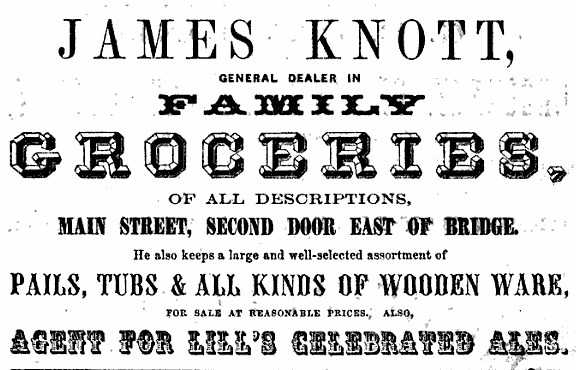
When James Knott was born about 1804, in Leicester, Leicestershire, England, his father, Thomas, was 13 and his mother, Anna, was 17. He was married three times and had three sons and two daughters. He died on March 5, 1874, in Elgin, Illinois, at the age of 70, and was buried there.
James KNOTT (1804 – 1874)
My 4th great-grandfather
daughter of James KNOTT & Deborah FLUDE
daughter of Lucy Flude KNOTT
son of Maria Elizabeth BLOW
daughter of Frederick Judson “Fred” HOAGLAND
son of Helen Marie HOAGLAND
The daughter of Capt. Frank Hunt BOSWORTH II
James Knott married Deborah Flude in 1822 in Leicester, Leicestershire, when he was 18 years old.
St. Nicholas Church – “England Marriages, 1538–1973 ,” database, FamilySearch (https://familysearch.org/ark:/61903/1:1:NJ8W-TQK : accessed 24 February 2016), James Knott and Debora Flude, 25 Aug 1822; citing St. Nicholas, Leicester, Leicester, England, ref
Read about Deborah Flude by clicking on this link:
https://thetenderlyrosecollection.wordpress.com/2016/08/30/deborah-flude-1800-1847/
Excerpt from British History Online:
“Of the other early shoemakers, James Knott advertised himself in 1842 as a ‘Fashionable Boot and Shoe Manufacturer’, who supplied the trade as well as private customers and executed shipping orders. He continued to appear with his son, Thomas, in the lists of boot and shoe manufacturers until 1850.”
‘The City of Leicester: Footwear manufacture’, A History of the County of Leicester: volume 4: The City of Leicester (1958), pp. 314-326. URL: http://www.british-history.ac.uk/report.
My note: Is it possible that the author of this history may have listed James as the father of Thomas in error. In my research, Thomas Knott was the father of James Knott. But, I am just beginning to gather information on this family, so I may be incorrect in my information. Would love to hear from anyone familiar with this family.
After Deborah’s death in 1847, James Knott arrived in America on June 28, 1849 in New York, New York after a 38 day voyage on the ship named Guy Mannering. The ship’s manifest lists James Knott 45, William Knott 18, Anne Knott 20, Eliz. Knott 16 and Fred Knott 12. His oldest child, Lucy, my GGG Grandmother, was not listed on the manifest with her family. I found she had traveled ahead of the family to America and was living with her Uncle John Knott in Chicago at the time of her family’s arrival.
Around 1849-1851, James Knott married Elizabeth Anne Hawly (1800-1852) in Illinois.
On the 1850 U.S. Federal Census the family is living in the Town of Elgin, Kane County, Illinois. The census lists James Knott 46, Elisabeth Knott 26, Elisabeth Knott 18, Frederick J. Knott 13. Only James is listed as having been born in Illinois. On the ship’s manifest for James Knott upon arrival to the U.S., an Elizabeth is listed, so at least that would indicated she was born in England, not Illinois. The same page of the census also shows his father, Thomas Knott 61 with Ann Knott 63-both born in England-his occupation is “Tanner or Tuner”.

After the death of James’ second wife, Elizabeth Hawly, he then married Charlotte Bunce on November 18, 1852.

James Knott is listed on the Illinois State Census for 1855 as residing in Elgin, Kane, Illinois.
A U.S. IRS Tax Assessment List for Illinois, District 2, for 1862-1864 lists James Knott as “Retail Dealer”, but then that was crossed out and it looks like “Butcher” was written beside it. Another U.S. IRS Tax Assessment List for the same district lists James Knott as “Retail Dealer”.
On the 1870 U.S. Census for Elgin, Kane, Illinois, James Knott is listed as “Retired Merchant” with possible wife (3 years younger), Charlotte Knott & Margaret Bunce (whom I found on a census in PA with George F. Knott on same page – Marg. was listed as domestic) at same address.
James Knott is listed as buried in the Channing Street Cemetery (Channing Street Cemetary Sexton’s Certificates) on March 5, 1874, however, the Channing Street Cemetery was “repurposed” for the building of a school. The story is here:
http://www.elginroots.com/index.php?option=com_content&view=article&id=18&Itemid=146
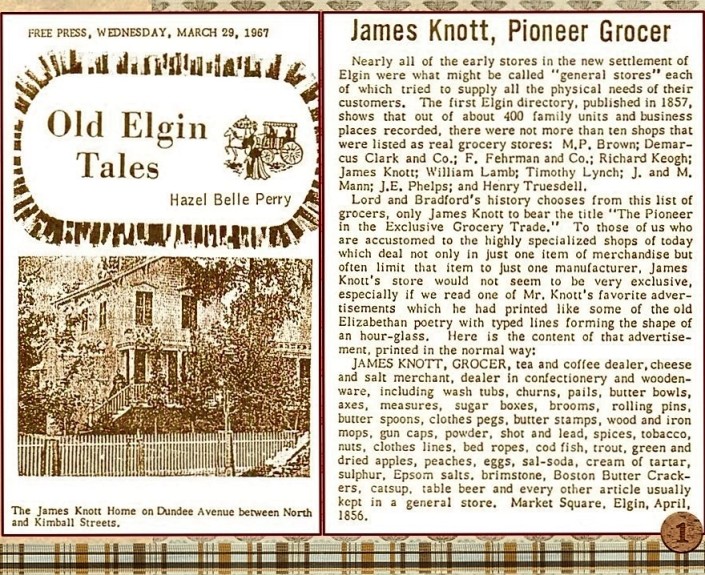
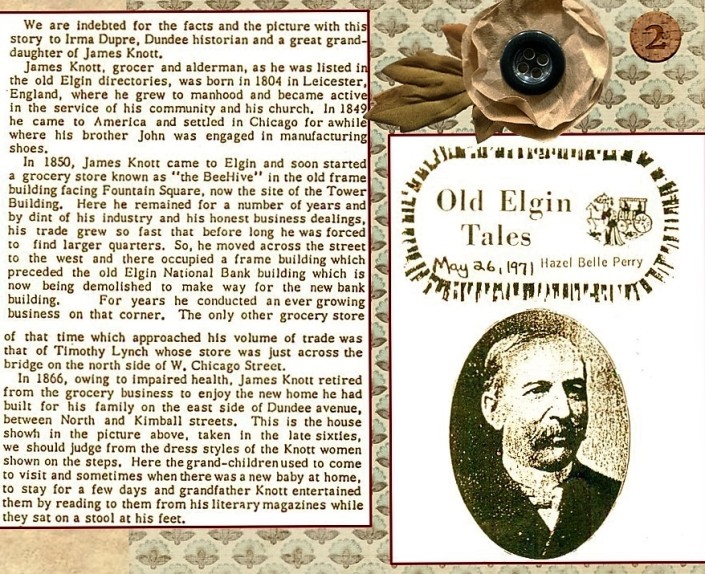
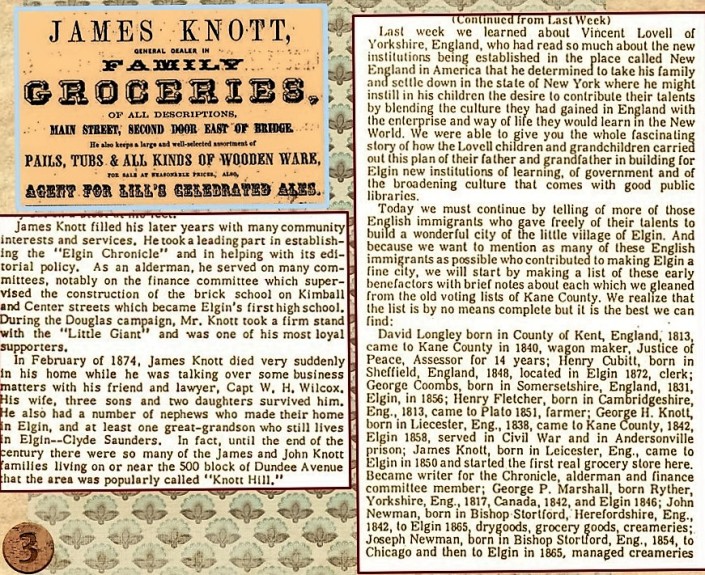
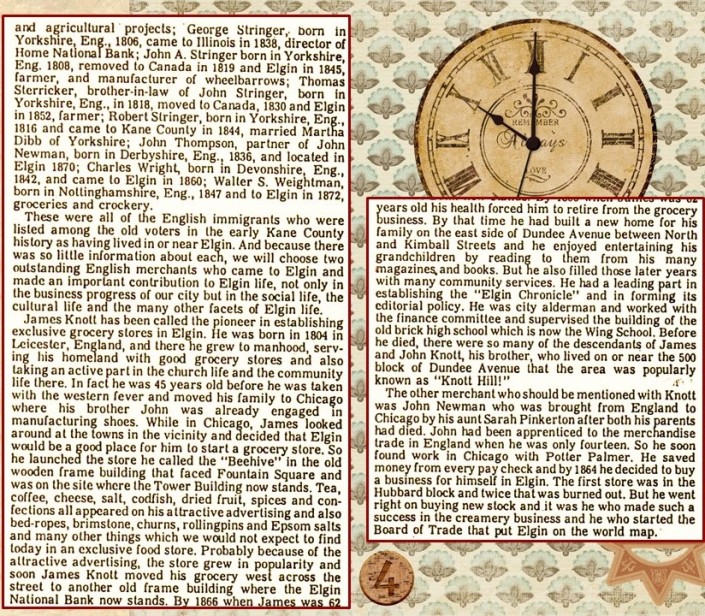
Deborah FLUDE (1800 – 1847)
Deborah FLUDE Knott (1800 – 1847)
My 4th great-grandmother
daughter of Deborah FLUDE
daughter of Lucy Flude KNOTT
son of Maria Elizabeth BLOW
daughter of Frederick Judson “Fred” HOAGLAND
son of Helen Marie HOAGLAND
The daughter of Capt. Frank Hunt BOSWORTH II
Forget Me Knott
BBC Leicester’s Tony Wadsworth goes in search of a Leicester woman who was born, married and buried in the same street.
How often do you pass familiar buildings, statues and objects in the street without giving them a second thought?
One sunny day BBC Leicester’s Tony Wadsworth stopped to take a look round the churchyard he walks past everyday, and found one woman’s remarkable story amongst the gravestones.
It got him thinking about the area around St. Nicholas Church and how it had changed since her days in the 1800s, and even in the last 50 years.
Deborah’s Death
Deborah’s death certificate states that she died of “enlargement of the liver” and “heart disease”.
BBC Leicester’s Julie Mayer spoke to Dr Clive Harrison to find out what could have caused Deborah’s poor health…
Leicester in the mid 1800s was a very different place from the city we know today and the environment would have affected everyone’s health.
In 1813 the Inspector of Nuisances, George Brown painted the city conditions as a radical risk to the health of its residents.
He said the River Soar was “torpid and turbid”, describing parts of it as an “open cesspool” emitting “pestiferous gasses which cause disease of the most malignant and mortal character”.
Doctors of the time often didn’t understand much more about disease than their patients; miasma, the belief that illness came from bad smells, was a popular concept.
Infant mortality was particularly high with a fifth of children dying before they reached the age of one.
In the 19th Century diarrhoea, consumption, scarlet fever and lung infections were all common causes of deaths.
With people living in cramped conditions, next to cesspits, abattoirs and stables, Clive believes it’s no wonder disease was rife.
Before the time of the NHS and antibiotics, city residents would normally be treated by local doctors who used reference books to give prescriptions from their own pharmacies.
There was just one hospital in the area during the 1800’s. Leicester Infirmary was founded in 1771 but was only open to a small section of society.
Overall Dr Clive said it was unsurprisingly Deborah had died of disease and all things considered she didn’t do too badly to last until 47 years-old: “I’d have said she was almost elderly.”
Life after Deborah
Although Deborah’s grave clearly marks her marriage to James Knott, her husband and children do not rest in the same churchyard.
Peter Cousins searched the 1851 census but was unable to find their names, “Husband, children – just disappeared off the face of Leicester.”
After quite a bit of thinking and investigating Peter traced down the family’s movements after the death of Deborah.
An 1849 shipping list reveals that James Knott, his sons William and Fredrick, and daughter Elizabeth, emigrated to America.
The travelled on the Guy Mannering ship on her first East-West voyage from Liverpool to New York on 22 May 1849.
The journey to the new world and their new home took 38 days.
After digging a bit deeper Peter found the Knott’s settled in Illinois the next year, with what appears to be a young wife for James:
“So he’s not only gone to start a new life, it looks like he’s started a new family.”
St. Nicholas Church, Leicester
In Search of Deborah
BBC Leicester’s Tony Wadsworth and Julie Mayer went in search of the woman who was born and buried on the same street in Leicester…
Deborah was born in 1800 on St. Nicholas Street, which is now a continuation of the High Street – just round the corner from the BBC Leicester studios.
At that time Leicester’s population would have rested at around 17,000 people. Her particular neighbourhood was small but densely inhabited.
Her unusually modern name, which first drew Tony to her story, was passed on from her older sister who died in infancy just a year before her arrival in the world.
She married James Knott in 1822 at St. Nicholas Church, at the age of 22. Find out more about marriage in the 1800s…
Weddings at this time would have been simple and quiet affairs, with just a few close family members witnessing their solemnisation of matrimony.
Local Historian Richard Gill commented, “this notion that we have to have 150 guests at your wedding and you have a huge slap up meal afterwards, that is actually middle to late 20th Century.
“It didn’t happen for my parents in the 1920s.”
A Different Life
Deborah continued to live with her husband on the same road she grew up on, raising six children in the process.
Local genealogist Peter Cousins discovered that at the time of the 1841 Census the children ranged from between three and 16 years-old:
“They were quite regular in their habits, you might say!”
James worked as a shoemaker, which was a common profession in an area home to many shoe factories, however Mrs Knott is likely to have been a housewife.
It is difficult to know how comfortably the Knotts lived as James’ specific position is unknown and could range from business owner to manual worker.
However Richard believes there may be some clues to the family’s wealth in Deborah’s gravestone – a smart but not overly elaborate piece made from local Swithland slate:
“This would rather suggest that there was at least sufficient money to memorialise her when she died.”
Deborah’s life in the 1800s would have been a very different experience to the Leicester women of today.
There were no aeroplanes, no electric light bulbs, no phones, no water pipes delivering fresh water, no flushing toilets, no NHS, and definitely no television or radio!
Leicester: 1800s
With the St. Nicholas area now home to several car parks and a developing park and ride scheme it is particularly interesting to consider that Deborah would have never seen a motor vehicle.
Very few areas of Leicester would still be recognisable to Deborah now, including the Guildhall, five medieval churches, a few chapels, the City Rooms, and a small network of streets south of St. Martins.
Richard said, “In the period in which she lived, that first half of the 19th Century, Leicester was very different and the sort of Leicester we think of as Victorian Leicester came more or less as was dying. So very little survives.”
Deborah died on 15 May 1847 at the age of 47 and was buried in the grounds of St. Nicholas Church in Leicester, where she remains to this day.
It may seem young to us now, but Richard believes it wouldn’t have been at all shocking in the 1840s:
“No drains, no deposal sewage, clean water uncertain – so one was pray to all kinds of things.
“And medicine was really just a case of nursing people, no antibiotics or anything like that, and often the flus in the winter and summer diarrhoea carried people off.
“So it may well be some people thought, ‘well she might have lived longer’, but 47 wasn’t bad.”
last updated: 04/09/2009 at 09:34
created: 07/07/2009
BBC
The story about Deborah as documented by Tony Wadsworth can be heard by clicking on this link and following the links within the story:
http://www.bbc.co.uk/leicester/content/articles/2009/07/07/deborah_knott_feature.shtml
